Agnes Garrett
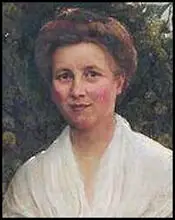
Agnes Garrett, the seventh of eleven children of Newson Garrett (1812–1893), merchant, and his wife, Louise Dunnell (1813–1903), was born on 12th July 1845 at Aldeburgh, Suffolk. Three of her sisters were Louisa Garrett, Millicent Garrett and Elizabeth Garrett. (1)
"The Garretts were a close and happy family in which children were encouraged to be physically active, read widely, speak their minds, and share in the political interests of their father, a convert from Conservatism to Gladstonian Liberalism, a combative man, and a keen patriot". (2)
Agnes's father had originally ran a pawnbroker's shop in London, but by the time she was born he owned a corn and coal warehouse in Snape, five miles Aldeburgh. Millicent later explained: "When railways became a practical proposition in our part of Suffolk my father exerted himself successfully to get a branch line, for goods only, extended to Snape." (3)
The business was a great success and by the 1850s Garrett could afford to send his children away to be educated. In 1858 she was sent to a private boarding school in Blackheath presided over by Miss Louisa Browning. (4) Millicent Garrett wrote in her biography, What I Remember (1924): "She was an aunt of the poet and a remarkable person in many ways. She ruled her school with a rod of iron; but she was a born teacher, and we all appreciated her thoroughness and method, especially as our ancient governess at home had been incompetent to the last degree." (5)
Agnes' sister, Elizabeth Garrett, was attempting to qualify as a doctor. and she took Millicent to see Frederick Denison Maurice, the founder of the Christian Socialist movement. Elizabeth and her other sister, Louise, brought her into contact with people with progressive political views. Elizabeth introduced her to Emily Davies, a woman who was active in campaigning for women's rights. On one occasion, Emily told Elizabeth, "It is quite clear what has to be done. I must devote myself to securing higher education, while you open the medical profession to women. After these things are done, we must see about getting the vote." She then turned to Millicent: "You are younger than we are, Millie, so you must attend to that." (6)
London Society for Women's Suffrage
In 1865 Agnes's sister Millicent Garrett was converted to the cause of women's suffrage in 1865 after hearing a speech made by John Stuart Mill during his campaign to be elected as the Liberal MP for the City of Westminster: "He (Mill) was, of course, a staunch upholder of an extended franchise which I should include the then voteless masses of working men and also women. I was a woman suffragist, I may say, from my cradle, but this meeting kindled tenfold my enthusiasm for it." (7) In 1867 Agnes joined the London Society for Women's Suffrage (LSWS). Soon afterwards, Agnes' eldest sister, Louisa Garrett Smith, who was Honorary Secretary of the LSWS died from appendicitis aged just 31. (8)
In April 1871, Agnes Garrett, along with Millicent Garrett Fawcett and Rhoda Garrett, spoke at a meeting in Framlingham. The local newspaper reported: "Miss Rhoda Garrett, who seemed perfectly self-possessed, said in opening the subject that she made no doubt the audience was well aware that the women's rights movement was regarded by a large number as a dangerous innovation, by others with scorn, and by many as a subject affording matter for fun and amusement. Of all three classes of objectors to women's suffrage she had, perhaps, the most sympathy with the first, as their opposition was thoughtful and reasoning. There were so many deeply rooted and cherished feelings with which women were hedged round to keep them in their 'proper sphere' that he who was bold enough to attempt to make a breach in the entrenchments was likely to meet with formidable obstacles." (9)
Arts and Crafts Movement
Agnes Garrett and her cousin, Rhoda Garrett became interested in the emerging Arts and Crafts movement. The philosophy was derived from the writings of John Ruskin and Thomas Carlyle. Ruskin acknowledged that he owed more to Carlyle "than to any other living writer". Ruskin considered the sort of mechanized production and division of labour that had been created in the industrial revolution to be "servile labour", and he thought that a healthy and moral society required independent workers who designed the things that they made. He believed factory-made works to be "dishonest," and that handwork and craftsmanship merged dignity with labour. (10)
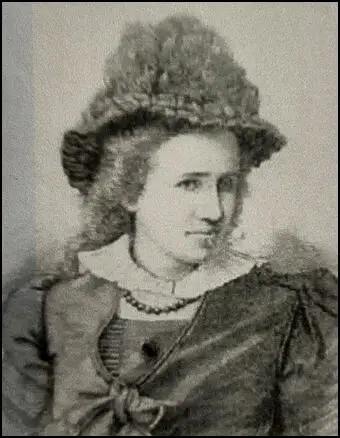
Ruskin agreed with Carlyle criticism of the industrial revolution and in The Stones of Venice: Volume II (1853) Ruskin argued that the working man had been reduced to the condition of a machine: "We have much studied and much perfected, of late, the great civilized invention of the division of labour; only we give it a false name. It is not, truly speaking, the labour that it divided; but the men; - divided into mere segments of men - broken into small fragments and crumbs of life; so that all the little piece of intelligence that is left in a man is not enough to make a pin, or a nail, but exhausts itself in making the point of a pin or the head of a nail. Now it is a good and desirable thing, truly, to make many pins in a day; but if we could only see with what crystal sand their points were polished, - sand of human soul, much to be magnified before it can be discerned for what it is - we should think that there might be some loss in it also... And all the evil to which that cry is urging our myriads can be met only in one way: not by teaching nor preaching, for to teach them is but to show them their misery, and to preach at them, if we do nothing more than preach, is to mock at it. It can only be met by a right understanding, on the part of all classes, of what kinds of labour are good for men, raising them, and making them happy; by a determined sacrifice of such convenience or beauty, or cheapness as is to be got only by the degradation of the workman; and by equally determined demand for the products and results of healthy and ennobling labour." (11)
William Morris later recalled: "To some of us when we first read it, now many years ago, it seemed to point out a new road on which the world should travel". Morris began experimenting with various crafts and designing furniture and interiors. Morris argued "without dignified, creative human occupation people became disconnected from life." He was personally involved in manufacture as well as design, which was the hallmark of the Arts and Crafts movement. Morris commented: "Have nothing in your houses that you do not know to be useful or believe to be beautiful." (12)
In 1861 William Morris established his own decorating company. It was originally formed to decorate his Red House. His partners included Ford Madox Brown, Dante Gabriel Rossetti, Edward Burne-Jones and Philip Webb. The company then began to take commissions. The first circular of the Firm proposed to undertake work in "any species of decoration, mural or otherwise, from pictures, properly so called, down to the consideration of the smallest work of art beauty." Morris designed wallpaper, Burne-Jones painted tiles for fire-places and Webb concentrated on producing furniture. (13)
The Firm's catalogues offered painted furniture, mural decoration, metalware and glass, embroidery and hangings, jewellery, and hand-painted tiles. Some of these products were made in the Firm's workshops, some were subcontracted. (14) Walter Crane later commented on the birth of the Arts and Crafts movement as "a revival of the medieval spirit (not the letter) in design; a return to simplicity, to sincerity; to good materials and sound workmanship; to rich and suggestive surface decoration, and simple constructive forms." (15)
According to E. P. Thompson: "By the 1870s the Firm was not only well established: it was beginning to set the pace among wealthy circles where any claim was made to cultivation. Even the fiercest opponents were forced to alter their designs, and to adapt some of the minor superficial characteristics of the Firm's work to their own. In short, Morris and Company... had become fashionable: and, moreover, the revolt had began to bring rich returns in the form of commercial success." (16)
Apprenticeship
The success enjoyed by William Morris inspired Agnes and Rhoda to become involved in this form of employment. As Millicent Garrett Fawcett pointed out, this was an extremely difficult thing to do: "Rhoda and Agnes determined to live together and get themselves trained as house-decorators, a thing quite as unprecedented then as women becoming doctors." (17)
Moncure D. Conway later reported: "Agnes and her cousin Rhoda Garrett, joined together to become house decorators. They were beautiful young ladies. They told me their adventures in trying to obtain training in their art. They went to the chief firm in London, whose manager was inclined to make fun of their proposal to become apprentices. Finding them skilful as designers, he said that if they were not women he could give them positions as subordinate directors in certain kinds of work." He then added: "Young women couldn't get along with workmen. How could you swear at them? And think of nice ladies running up ladders!" (18)
After her marriage Elizabeth Garrett Anderson approached Daniel Cottier about helping her to redecorate her house at 20 Upper Berkeley Street in London. Cottier had trained under Ford Madox Brown and was part of the Arts and Crafts movement. Elizabeth also asked him to take on Rhoda, aged 30, and Agnes, aged 26, as apprentices. They were to remain with Cottier for about a year and a half but there is a suggestion that they felt they were not being taught enough. (19)
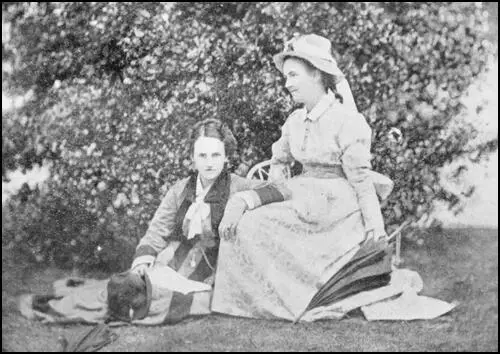
In 1873 Rhoda and Agnes apprenticeship was transferred to John McKean Brydon, a young architect who was highly supportive of women's rights. (20) The following year Rhoda and Agnes toured England in search of inspiration and ideas and according to Moncure D. Conway that when "their apprenticeship reached its last summer (the Garretts) went on a tour throughout England, sketching the interiors and furniture of the best houses, which were freely thrown open to them." (21)
R & A Garrett Company
In 1874 the Garretts became the first British women to open an interior design business. The company, called R & A Garrett, designed furniture, chimney-pieces, and wallpapers in the Queen Anne style and aiming at middle-class people with moderate incomes... Among their commissions were the new women's university colleges." (22) One of their first commissions was to decorate 4 Upper Berkeley Street, the home of Elizabeth Garrett Anderson. They were to go on to successfully decorate many private houses. (23)
In May 1875, Rhoda and Agnes moved into 2 Gower Street on the corner of Bedford Square, Bloomsbury. Maude Parry: later pointed out: "Lady pupils in an architect's office being a thing altogether undreamt and unheard of. Having learnt their trade, they soon established themselves as decorators in 2, Gower Street, their firm being the first and only one registered for ladies. A cottage room exhibited by them in the Trocadero at the French Exhibition of 1878 gained very general admiration for its original and simple style; and the Miss Garretts after long protracted and patient work attained that success which was so justly their due." (24)
Rhoda Garrett also gave lectures on interior design. On 17th October 1876, she read a paper at the annual meeting of the National Association for the Promotion of Social Science in Liverpool: She argued: "The first step for carrying out any improvements in the house must be to devise some means of giving an appearance of better proportion to the rooms. It is easy to see that the height is out of proportion, and thus the area of the room is apparently reduced. The effect of bad proportion is further increased by the unbroken uniformity of the wall surfaces; there are not, as in the carefully planned rooms of an earlier period, any of those ancient recesses and corners, which, of themselves, suggested a pleasing picturesqueness in the treatment of rooms. When, as is generally the case, the rooms are thus too high, and the surfaces of the walls continuous and unvaried, the disagreeable effect can be in some degree modified: first, by dividing the wall by means of strings, cornices, or panels, and secondly, by a careful attention to the colouring of both walls and ceilings. It can easily be imagined that, if instead of covering the entire surface of the walls with an obtrusive paper of bad design and crude colour, some plan were adopted for dividing the height by means of wooden mouldings fixed to the wall so as to form either a dado or a deep frieze, the room would be brought into more graceful proportions. The divisions thus formed might be decorated in various ways, care being taken to get the deeper and heavier colour at the bottom of the room and the lighter towards the top." (25)
In 1876 Agnes and Rhoda published their book, Suggestions for House Decoration in Painting, Woodwork, and Furniture. In a letter to the publisher, Alexander Macmillan, Rhoda explained the contents of the book: "An account of the more simple ways in which, without great expense, a home might be made pretty & also wholesome; with designs & illustrations of furniture the whole to consist of a kind of narrative, in which a house is described on which a great deal of money has been spent with a bad result, and the simple cheap way in which the same house may be made to look well." (26) The book was extremely successful and six editions appeared over the next three years. (27)
The composer, Hubert Parry, was one of their early customers. He became a close friend and stayed with the cousins at 2 Gower Street in May 1876: "I was never so spoilt in my life. They seem to divine all one's wants before one has thought of them oneself. They are the best company I ever knew, and to live in their house is a very great deal of happiness in itself. The quiet and soothing colour of the walls and decoration and the admirable taste of all things acts upon the mind in the most comforting manner. I was quite excised of the vulgar idea that everything ought to be light & gaudy & covered with gilt in London. All these are a sure element of discomfort in a house, ones eye wants rest & nothing shows the dirt & dust of London so soon as light colours of gilding." (28)
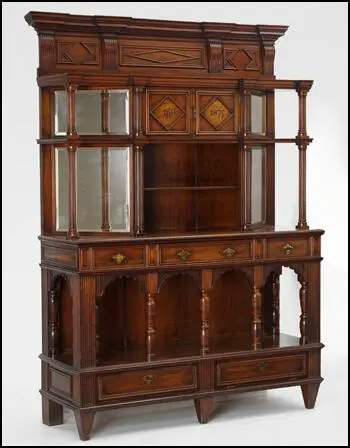
The composer Ethel Smyth, also an activist in the women's suffrage movement, became friends with Rhoda and Agnes Garrett, whom she wrote about in her memoirs, Impressions That Remained (1919). Smyth recalled "The beauty of the relation between the cousins, and of that home life in Gower Street, remains with us who knew them as certain musical phrases haunt the melomaniac, and but for Agnes, who stood as far as was possible between her and the slings and arrows which are the reward of pioneers, no doubt Rhoda's life would have spent itself earlier. Her every burden, human and otherwise, was shouldered by Agnes, and both had a way of discovering waifs and strays of art more or less worsted by life whose sanctuary their house henceforth became." (29)
One of their first commissions was the Kensington home of the composer, Hubert Parry. Rhoda and Agnes Garrett exhibited at the Arts and Crafts Exhibition Society and Exhibition of Women's Industries and were members of the Royal Archaeological Society and the Society for the Preservation of Ancient Buildings. (29a)
Rustington
Hubert Parry and Maude Parry decided they wanted to live in the small village of Rustington in West Sussex. In June 1878 he wrote in his diary: "In the afternoon Maudi & I drove down to Rustington, to see some houses which were to be let, one 'The Grange' is quite an ideal snuggery, & would have done for me to perfection, but has been snapped up under our very noses." (30)
Soon afterwards the Parrys rented Cudlow House. Rhoda and Agnes and liked the village so much that in 1879 began renting Firs Cottage, just west of the Parish Church of St Peter and St Paul. "It consisted of a largish, though rather dark drawing room and a front hall and large old kitchen with a stone floor and an old pump." (31)
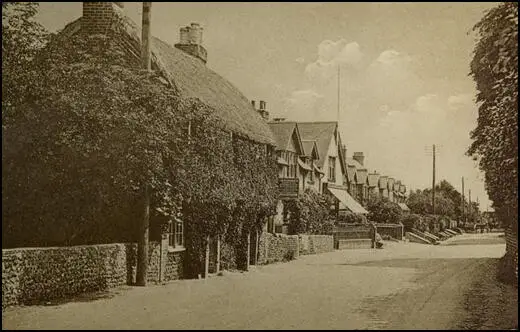
In the summer of 1881, Ethel Smyth spent a lot of time with Agnes and Rhoda: "They rented an old thatched cottage at Rustington of which they had made the most perfect of habitations, and the summer holidays and any odd days they could snatch from business were spent there. Rustington was then quite an unfrequented spot - a few straggling cottages and farmhouses, a fine Norman Church, sometimes flicked by spray when south-west gales blew, and an almost deserted beach." (32)
Death of Rhoda Garrett
Rhoda Garrett caught typhoid at the end of October 1882. Ten days later she developed bronchitis. Her friend, Alice Stansfield, sent a postcard to Hubert Parry who noted in his diary: "In the evening after dinner I was playing when she walked in with a fixed expression on her face and said something which I did not catch, and handed me a postcard from Alice Stansfield, on which were written only the cruel words 'No more hope'. She was my food and brain, but unnaturally quiet, and still both hope that better news may come tomorrow." (33)
The following day Parry wrote in his diary: "Met the postman in the morning and he handed me a note from Agnes telling me that the blow had fallen, and dear Rhoda had died yesterday. Even in her desolation Agnes thought for Maude, and wanted me with a kindness for her so that I might tell her in the best way to avoid a shock. Maude took it very well, but gradually succumbed under it. Maude and her spent much time together, and I thought best to leave them alone, but they must have been taken with much weepings before their spirits could approach any sort of quietude again. It was a terrible day." (34)
Rhoda Garrett died on 22nd November 1882 at 2 Gower Street, London. Her death certificate was signed by Elizabeth Garrett Anderson and she was buried in the churchyard at Rustington. The Times obituary commented: "Her delicate taste, her refined sense of fitness, her capacity for taking trouble soon recommended to a large and admiring circle. She has just reached its border land of assured success when her health finally broke down. She is lamented by many friends to whom she endeared herself not only by her cheerful and frequently brilliant conversation, but by her unwavering kindness. Having known what it was to struggle, she was always ready with a helping hand, and her influence on the rising generation of fellow artists – and, indeed of male artists as well – will long be felt." (35)
Rhoda's half-brother, Edmund Garrett, wrote in a letter to Maude Parry: "What you say is exactly true. She was different from everyone else. Others might be good, others earnest, but there never was another Rhoda, there is only one, and I think there never will be another. That shows her genius; but the myriad of things that show her perseverance and hard work and unselfishness are to me the most comforting and valuable. We are born with talents; and if we have genius, it is ours from birth... it is steadfast earnest use of abilities that strikes me most; it seems so unattainable, so much above. Rhoda was one among a thousand in her wonderful charm and influence and genius but she was one among a million in the use she made of these; - I hardly know yet what a hole her loss has made in my life." (36)
Political Activism
Agnes continued the company after Rhoda's death. In 1888 designed a complete interior consisting of carpets, furniture, metalwork, wallpaper, and woodwork for the first exhibition of the new Arts and Crafts Exhibition Society. After the death of Henry Fawcett in 1884, Millicent Garrett Fawcett moved in with her sister at 2 Gower Street, London. (37)
Evelyn Sharp became close friends with the two sisters. Sharp wrote in her autobiography, Unfinished Adventure (1933): "There was a strong family likeness in all the Garretts; and their fine sterling qualities, added to much that was personally attractive, made me feel proud to be a member of the house party that included three of the sisters of the older generation. Miss Agnes Garrett used to accompany Mrs. Fawcett everywhere, and when they both joined us at Newtonmore, the conversation became noticeably more racy, enlivened as it was with many excellent anecdotes gathered in their wanderings about the world. Nothing seemed to daunt these doughty women, and although I have always rather prided myself on wearing suitable clothes and yielding easily to the demands of a simple country life, I felt nothing but an artificial inhabitant of cities when I saw them tuck up their skirts - there was plenty to tuck up in those days - and don indescribable boots, before starting out to brave inclement weather and face really difficult rambles in the mountains above Speyside. I wondered sometimes if, thirty or forty years later, I should be able at the same age to show half their energy and unassailable good health." (38)
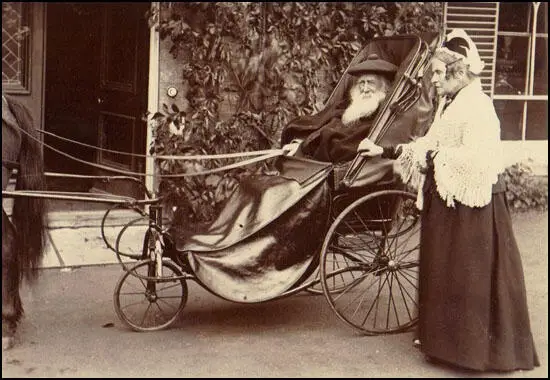
Agnes Garrett continued her interior design business until 1905. Agnes remained active in the women's suffrage movement and was a member of the National Union of Women's Suffrage Societies (NUWSS). In early 1912 the NUWSS took the decision to form an electoral alliance with the growing Labour Party, as the only political party which really supported women's suffrage. Agnes Garrett helped to fund this venture. "It soon strengthened that alliance, setting up a special Election Fighting Fund in May-June so that the NUWSS could help Labour candidates more effectively at by-elections." (39)
The Qualification of Women Act was passed in February, 1918. The Manchester Guardian reported: "The Representation of the People Bill, which doubles the electorate, giving the Parliamentary vote to about six million women and placing soldiers and sailors over 19 on the register (with a proxy vote for those on service abroad), simplifies the registration system, greatly reduces the cost of elections, and provides that they shall all take place on one day, and by a redistribution of seats tends to give a vote the same value everywhere, passed both Houses yesterday and received the Royal assent." (40)
The National Union of Women's Suffrage Societies became the National Union of Societies for Equal Citizenship (NUSEC) in March 1919. Eleanor Rathbone succeeded Millicent Fawcett as president of the new body. Agnes Garrett was elected vice-president. Later that year Rathbone persuaded the organization to accept a six point reform programme. (i) Equal pay for equal work, involving an open field for women in industry and the professions. (ii) An equal standard of sex morals as between men and women, involving a reform of the existing divorce law which condoned adultery by the husband, as well as reform of the laws dealing with solicitation and prostitution. (iii) The introduction of legislation to provide pensions for civilian widows with dependent children. (iv) The equalization of the franchise and the return to Parliament of women candidates pledged to the equality programme. (v) The legal recognition of mothers as equal guardians with fathers of their children. (vi) The opening of the legal profession and the magistracy to women. (41)
As a result of the 1928 Equal Franchise Act all women over the age of 21 could now vote in elections. Many of the women who had fought for this right were now dead including Elizabeth Garrett Anderson, Barbara Bodichon, Dorothea Beale, Lydia Becker, Clementina Black, Jessie Boucherett, Mary Clarke, Emily Davies, Elsie Duval, Elizabeth Wolstenholme-Elmy, Isabella Ford, Rhoda Garrett, Cecilia Wolseley Haig, Elsie Inglis, Constance Lytton Mary Macarthur, Rachel McMillan and Emmeline Pankhurst. The act enfranchised an additional 5,221,902 women. (42)
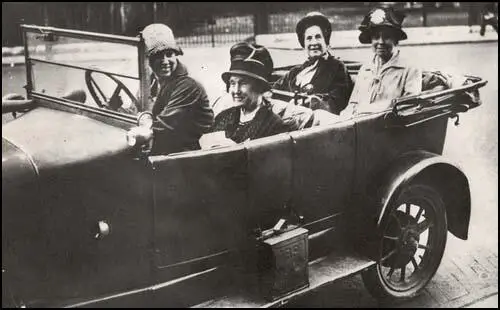
the passing of the 1928 Equal Franchise Act (2nd July, 1928)
Some veterans of the campaign such as Agnes Garrett and Millicent Garrett Fawcett were still alive and had the pleasure of attending Parliament to see the vote take place. That night Millicent wrote in her diary: "It is almost exactly 61 years ago since I heard John Stuart Mill introduce his suffrage amendment to the Reform Bill on May 20th, 1867. So I have had extraordinary good luck in having seen the struggle from the beginning." (43)
Agnes Garrett died aged 89 on 19 March 1935 at 2 Gower Street, London, having outlived all of her siblings.
Primary Sources
(1) Millicent Garrett Fawcett, What I Remember (1924)
Rhoda was a little older than we were, of brilliant capacity and great personal attractiveness, witty and very ready with her wit. Her mother had died in her early childhood, and after several years of widowhood her father had married again, and a fairly rapid succession of babies appeared once more in the Elton Rectory. The three children of the first marriage were almost by force of circumstances pushed out of the parent nest. One son went to New Zealand and stayed there; one was in an office in London; and it became a question what should Rhoda do? At that time governessing was practically the only professional career open to a woman...
Our school friendship, and especially that which Rhoda formed with Agnes, almost at the same time had important consequences. After my marriage, in 1867, Rhoda and Agnes determined to live together and get themselves trained as house-decorators, a thing quite as unprecedented then as women becoming doctors. Rhoda also took an active part in the agitation led by Mrs. Butler against the Contagious Diseases Acts of 1866 and 1868 and in working for Women's Suffrage. She became a speaker of extraordinary power and eloquence. Many of her hearers declared her to be quite unequalled for her combination of humour with logic and closely reasoned argument. Sometimes the newspaper comments were very droll. One which sticks in my memory ran thus: "The lecturer, who wore no hat, was youthful but composed, feminine but intelligent."
(2) The Dundee Courier (6th March 1873)
It is stated that Mr Ruskin, who has lately given up his house in Denmark Hill, and has bought a small estate at Coniston Lake, Cumberland, is now engaged with Lady Trevelyan in painting a house. House decoration is one of the fine arts, one which Mr Morris and Mr D. Rossetti have brought to great perfection Miss Agnes Garrett, sister of Mrs Anderson and Mrs Fawcett, and Miss Rhoda Garrett, her cousin, have made it their profession.
(3) Evelyn Sharp, Unfinished Adventure (1933)
There were occasional, very occasional, holidays at home during the years of the suffrage agitation. Two that stand out especially in my memory were spent at Newtonmore in Inverness-shire. Here I was the guest of Dr. Elizabeth Garrett Anderson, who had a summer cottage in that beautiful part of the Highlands. I went there on both occasions with her daughter Dr. Louisa Garrett Anderson, and we had great times together climbing the easier mountains and revelling in wonderful effects of colour that I have seen nowhere else except possibly in parts of Ireland. Only those who were engulfed in the preoccupations of those militant years could appreciate what it meant to us to get away from it all for a week or two, although our peace was twice invaded by the campaign we thought we had left behind, when Mrs. Fawcett (my hostess's sister) and Mrs. Pankhurst stayed with us, each in the course of conducting a speaking tour. It was, however, so entertaining to meet both these famous public characters in the more intimate and human surroundings of a summer holiday that we did not grudge the time given to working up a suffrage meeting in the village instead of tramping about the hills.
Old Mrs. Garrett Anderson-old only in years, for there was never a younger woman in heart and mind and outlook than she was when I knew her before the war was a fascinating combination of the autocrat and the gracious woman of the world. I thought one of her brothers summed her up rather delightfully, one day, when, contrary to everybody's entreaties and advice, she insisted on clambering down a steep incline under the unshakable impression that it was a short cut home." You must make allowances, I suppose, for her being the first woman doctor," he observed, when she had had time to realise her error and he was setting off to fetch her back. Undoubtedly, like Florence Nightingale and other reformers who have had to fight both prejudice and vested interests, if Elizabeth Garrett Anderson had been the sweetly reasonable person who always believes what she is told without questioning it, she would not have been the pioneer who opened the medical profession to women. In her own home she was a most hospitable and lovable hostess, and had a delicious sense of humour, which may have been one reason why she was instantly attracted towards the militant branch of the suffrage movement when it became prominent. Her daughter, who brought the same gifts of courage and perception, so rare in combination, to the service of the same cause, inherited all her mother's brains and culture, and more than her personal charm and gentleness. Her friendship was one of those I gained at that troublous time, and it offered generous compensation for many losses.
There was a strong family likeness in all the Garretts; and their fine sterling qualities, added to much that was personally attractive, made me feel proud to be a member of the house party that included three of the sisters of the older generation. Miss Agnes Garrett used to accompany Mrs. Fawcett everywhere, and when they both joined us at Newtonmore, the conversation became noticeably more racy, enlivened as it was with many excellent anecdotes gathered in their wanderings about the world. Nothing seemed to daunt these doughty women, and although I have always rather prided myself on wearing suitable clothes and yielding easily to the demands of a simple country life, I felt nothing but an artificial inhabitant of cities when I saw them tuck up their skirts - there was plenty to tuck up in those days - and don indescribable boots, before starting out to brave inclement weather and face really difficult rambles in the mountains above Speyside. I wondered sometimes if, thirty or forty years later, I should be able at the same age to show half their energy and unassailable good health.
(4) Ethel Smyth, Impressions that Remained (1919)
Barbara Hamlet had often spoken to me of Agnes and Rhoda Garrett, who were among the first women in England to start business on their own account and by that time were well-known house decorators of the Morris school. Agnes was sister to Mrs Fawcett and Dr Elizabeth Garrett Anderson - Rhoda, their cousin, rather older than Agnes, daughter of a clergyman whose second wife had practically turned her predecessor's children out of the house to fend for themselves. Late in the autumn of 1880 Barbara introduced me to these great friends of hers, and during the next two years their house became the focus of my English life owing to the friendship that sprang up between Rhoda and me.
Both women were a good deal older than I, how much I never knew - nor wished to know, for Rhoda and I agreed that age and income are relative things concerning which statistics are tiresome and misleading. How shall one describe that magic personality of hers, at once elusive and clear cut, shy and audacious? - a dark cloud with a burning heart - something that smoulders in repose and bursts into flame at a touch. ...Though the most alive, amusing, and amused of people, to me at least the sombre background was always there - perhaps because the shell was so obviously too frail for the spirit. One knew of the terrible struggle in the past to support herself and the young brothers and sisters; that she had been dogged by ill-health as well as poverty - heroic, unflinching through all. Agnes once said to me, 'Rhoda has had more pain in her life than was good for her,' but no one guessed that like her brother Edmund - champion of Rhodes, youthful collaborator with Lord Milner, cut off at the zenith of his powers - she carried in her the seeds of tubercular disease. And yet when the end came there was little of surprise in one's grief; thus again and again had one seen falling stars burn out.
I spoke of her humour; on the whole I think she was more amusing than anyone I have ever met - a wit half scornful, always surprising, as unlike everyone else's as was her person ... a slim, lithe being, very dark, with deep-set burning eyes that I once made her laugh by saying reminded me of a cat in a coal scuttle. Yet cat's eves are never tender, and hers could be the tenderest in the world.
I always think the feel of a hand as it grasps yours is a determining factor in human relationships, and all her friends must well remember Rhoda's - the soft, soft skin that only dark people have, the firm, wiry, delicate fingers. My reason tells me she was almost plain, but one looked at no one else when she was in a room. There was an enigmatic quality in her witchery behind which the grand lines, the purity and nobility of her soul, stood out like the bone in some enchanted landscape. No one had a more subtle hold on the imagination of her friends, and when she died it was as if laughter, astonishment, warmth, light, mystery, had been cut off at the source. The beauty of the relation between the cousins, and of that home life in Gower Street, remains with us who knew them as certain musical phrases haunt the melomaniac, and but for Agnes, who stood as far as was possible between her and the slings and arrows which are the reward of pioneers, no doubt Rhoda's life would have spent itself earlier. Her every burden, human and otherwise, was shouldered by Agnes, and both had a way of discovering waifs and strays of art more or less worsted by life whose sanctuary their house henceforth became.
I think I have never been happier in my life than at the old thatched cottage they rented at Rustington. An exhausting fight against the stream of prejudice, such as the Garretts had waged for many years, was not to be my portion till later. Of course both cousins and all their friends were ardent Suffragists, and I wonder now at the patience with which they supported my total indifference on the subject - an indifference I was to make up for thirty years later.
Their great friends the Parrys had a house close by, and besides helping me with invaluable musical criticism and advice Hubert Parry lent me a canoe, in which on very calm days, cautiously dressed in bathing costume, I put out to sea. There too I got to know the Fawcetts, and saw how that living monument of courage, the blind Postmaster General, impressed the country people as he strode up and down the hills in the company of his wife. I thought Mrs Fawcett rather cold, but an incident that happened the summer after the death of Rhoda, to whom she was devoted, taught me otherwise. One day when I was singing an Irish melody I had often sung at Rustington - 'At the Mid Hour of Night' - I suddenly noticed that tears were rolling down her cheeks, and presently she got up and quietly left the room. After that for many years I never saw her. Then came the acute Suffrage struggle, during which the gulf that separated Militants from National Unionists belched forth flames, but through all those years, remembering that incident, I always thought of Mrs Fawcett with affection.

